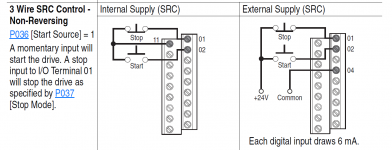Bold Italics are mine.
I'm having a troubleshooting error that I just can't seem to figure out. Several years ago, I designed and built an industrial control panel for power six corner conveyors for a customer. Six Allen-Bradley Powerflex 523 drives power 1HP 480VAC motors. I used a 24VDC 2-wire SRC non-reversing control circuit with an external power supply. A SPDT relay is held closed to provide the RUN command to the VFDs. Each motor is individually controlled with its on set of operators.
Judging from your narrative, I can infer that the schematic diagram is the AS BUILT drawing that the system is based on.. . . although I noticed that some needed information is (are) missing. You have two VFDs presently installed and you added four VFDs.
Initially, only two of the six conveyors were installed and used. The production manager knew that changes would be made, so the conveyor lines were not finalized. The two conveyors worked well with no faults for well over a year. Several months ago, the final four powered conveyors were installed. Previously, the plan had been for a single set of operators and a single potentiometer to control the speed and operation of VFDs 3-6, but the company decided to split them up and have each individually controlled. I added more pushbutton enclosures, added a few relays, and re-wired part of the panel.
The sequence of operation of the six conveyors is what I’m missing. I don’t know if leaving them out in your drawing was done purposely. It maybe because you felt they are not important when asking for guidance?
Another aspect in the operation of those conveyors-- is the SEQUENCE of operation.
Do all conveyors operate sequentially as in Conveyor 7 is fed by Conveyor 6, Conveyor 6 is fed by Conveyor 5 while Conveyor Conveyor 5 is fed by Conveyor 4. . . . so forth and so on?
Do they operate in conjunction with rest of the conveyors?
This question my sound mundane but since you added the four conveyors using the existing control power--this does have some impact on the electronics circuitry of the VFDs.
Bear with me and I’ll explain albeit briefly.
In Electronics there are seven different GROUNDS.
1. Analog ground
2. Digital ground
3. Common ground
4. Chassis ground
5. Power ground
6. Signal ground
7. Earth ground
Electronic Engineers have a contemptuous kinship with Electrical Engineers when designing control circuits. lol
For Electrical Engineers . . . ground is ground—bury your dead down there.
Electronics Engineers "meme" for ground as derived from mantra:
Ground is where POTATOES and CARROTS belong. lol
Since making the changes, I've had a problem with two of the conveyors; VFD 2 (one of the initial two VFDs) and VFD 4 (one of the recent additions). Both of these conveyors will occasionally stop, but will start again as soon as the operator presses the START pushbutton. The relay will de-energize and open the N.O. contact, breaking the circuit and no longer providing the RUN command to the VFD. At first, I was only told that it was a single conveyor (VFD 2) that was stopping. As it had been running fine for quite some time, I assumed that it was simply a relay coil with a unexpectedly short life. I replaced the coil and assumed that the problem would be corrected.
It did not resolve the error, and I was then informed that a second conveyor (VFD 4) was also behaving the identically; it would intermittently stop, but would start without fail as soon as the START operator was pressed.
If you interconnected these “ grounds” especially in the VFD input. . . in the VFD side you could expect funny results.
Going into the “MOLECULAR LEVEL” is not the premise of this forum.
I will be talking to myself if I did.
Some appropriate websites that could explain this . . . .but you are only concerned of the adverse effect of improperly “grounded “ electronics circuitry.
Remember that a complicated problem like you have could be something not mentioned here. Just one call doesn’t explain them all.
The control panel has a compressed air panel cooler, controlled by a 24VDC thermostat and 24VDC solenoid valve. I thought that perhaps when the thermostat was opening the solenoid valve, it was causing a voltage drop and de-energizing some of the more voltage sensitive relays. Extensive manipulation of the valve did not replicate the problem, and the problem remained even when the thermostat was turned off. Additionally, the power supply is 100W and neither read a voltage drop when the solenoid opened, or an excessive surge in load. I have been unable to find the electrical specifications of the solenoid valve, but no other components within the control panel amount to a very significant DC load. At no point have any of the VFDs faulted, they simply stop receiving the RUN command and the conveyor motor is stopped.
My most recent solution was to replace the N.O. and N.C. contact, and the LED indicator in the the pushbutton enclosure for VFD 2, as well as blow out the enclosure with compressed air, but after returning several weeks later, the fault remains today. My mentor is at a loss, as well.
I am at an absolute loss as to the next step for troubleshooting or most likely repair. I've been attempting to attach images of my schematics, but am having trouble properly compressing the images small enough to make the server happy.
Any guidance or insight would be most appreciated.
Good Luck and may you prosper.
Fish


